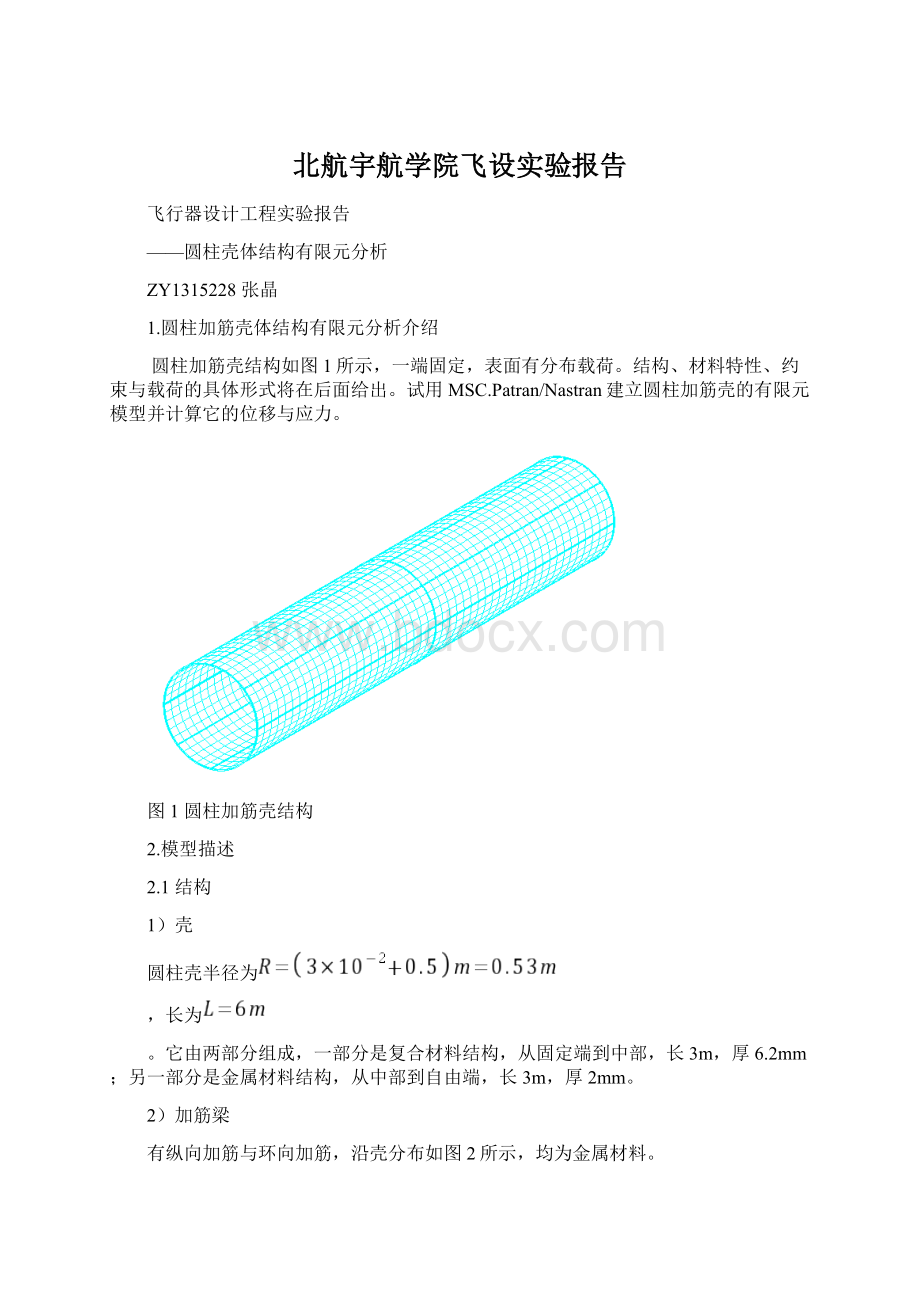北航宇航学院飞设实验报告.docx
《北航宇航学院飞设实验报告.docx》由会员分享,可在线阅读,更多相关《北航宇航学院飞设实验报告.docx(21页珍藏版)》请在冰豆网上搜索。

北航宇航学院飞设实验报告
飞行器设计工程实验报告
——圆柱壳体结构有限元分析
ZY1315228张晶
1.圆柱加筋壳体结构有限元分析介绍
圆柱加筋壳结构如图1所示,一端固定,表面有分布载荷。
结构、材料特性、约束与载荷的具体形式将在后面给出。
试用MSC.Patran/Nastran建立圆柱加筋壳的有限元模型并计算它的位移与应力。
图1圆柱加筋壳结构
2.模型描述
2.1结构
1)壳
圆柱壳半径为
,长为
。
它由两部分组成,一部分是复合材料结构,从固定端到中部,长3m,厚6.2mm;另一部分是金属材料结构,从中部到自由端,长3m,厚2mm。
2)加筋梁
有纵向加筋与环向加筋,沿壳分布如图2所示,均为金属材料。
图2圆柱壳上加筋梁分布
纵向加筋共八条沿周向对称分布如图3所示,截面形状为L型,具体尺寸与指向如图4所示。
图3周向对称分别L型梁R=0.53m图4L型梁截面尺寸w=h=10mmt=3mm
环向加筋共3条,分别位于壳的两端与中部,截面形状为矩形,具体尺寸如图5所示。
图5矩形梁截面尺寸w=h=10mm
2.2材料
1)金属材料
即copper,
,
。
2)复合材料
面板(facesheet):
,
,
,
。
芯(core):
,
,
,
,
,
。
层合板:
由面板和芯组成,具体铺层形式和方向如图6所示。
其中每层面板厚0.3mm,芯厚5mm。
图6复合材料铺层
2.3约束与载荷
圆柱壳一端固定,如图7所示。
图7固定端
壳的内表面有分布载荷
(Y轴如图3所示)。
3.建模过程
3.1几何模型的建立
1.建立新的数据库,输入全局参数,最大尺寸为6米
File/new
Newdatabasename:
sylindricalshellstructure
Ok
⏹Basedonmodel
Approximatemaximunmodel
Dimesion:
6.0
Analysiscode:
MSC.Nastran
Analysistype:
structure
Ok
2.建立名为”shell”的一个新组
Group/create
Newgroupname:
shell
⏹Makecurrent
Apply
Cancle
3.绘制一半径为0.5m的圆,并通过面拉伸命令形成壳体
⏹Geometry
Actioncreat
Objectcurve
Method2DCircle
Circleradius0.5
Constructionplanelistcoord0.3
Centerpointlist[000]
Apply
Actioncreate
Objectsurface
Methodextrude
Tanslationvector<003>
Curvelistcurve1
Apply
4.复制刚刚生成的圆柱壳体
Actiontranform
Objectsurface
Methodtranslate
Surfacelistsurface1
Directionvector<001>
Vectormagnitude3
Repeatcount1
Apply
5.建立一个新的组取名为”circular_beam”
Group/create
Newgroupname:
circularbeams
⏹Makecurrent
Apply
Cancle
6.通过复制生成另外两个圆形梁曲线
Actiontranform
Objectcircle
Methodtranslate
Curvelistcurve1
Directionvector<001>
Vectormagnitude3
Repeatcount2
Apply
7.纵向筋的绘制,建立一个名为”longitudinalbeams”的新组
Group/create
Newgroupname:
longitudinalbeams
⏹Makecurrent
Apply
Cancle
8.沿长度方向创建一条直线
Actioncreat
Objectcurve
Methodpoint
Stardingpointpoint1
Endingpointpoint3
Apply
9.通过旋转的方法创建8条直线,旋转角度为45°
Actiontransform
Objectcurve
Methodrotate
Rotationangle45
Repeatcount7
Curvelistcurve4
Apply
图31几何模型建立完成
1.1显示组”shell”,并设置为当前组
Group/post
Selectgrouptopost:
shell
Apply
Cancle
3.2有限元网格划分
1.将组”shell”设置为当前组
Group/post
Selectgrouptopost:
shell
Apply
Cancle
2.生成”meshseed”
⏹Elements
Actioncreate
Objectmeshseed
Typeuniform
Numberofelements:
Number=32
Curvelistcurve1
Apply
Numberofelements:
Number=30
Curvelistsurface1.12.1
Apply
3.选择”isomesh”,生成四边形单元
Actioncreat
Objectmesh
Typesurface
Elemshapequad
MesherIsoMesh
TopologyQuad4
Surfacelistsurface12
Apply
4.显示组“longitudinalbeams”并且设置为当前组
Group/post
Selectgrouptopost:
longitudinalbeams
Apply
Cancle
5.用curve的方式划分longitudinalbeams的网格
Actioncreat
Objectmesh
Typecurve
Topologybar2
curvelistcurve4:
11
Apply
6.显示组“cicularbeams”并设置为当前组
Group/post
Selectgrouptopost:
circularbeams
Apply
Cancle
7.用curve的方式划分circularbeams的网格
Actioncreat
Objectmesh
Typecurve
Topologybar2
curvelistcurve1:
3
Apply
8.节点等效
在面的边上重复创建了节点,因此需要将节点等效
Action:
equivalence
Object:
all
Type:
tolerancecube
Equivalencetolerance:
0.004
Apply
图3-2有限元网格划分完成
3.3材料属性添加
3.3.1复合材料的添加
1.facesheet和core材料添加
⏹Material
Action:
create
Object:
2dorthotropic
Method:
manualinput
Materialname:
facesheet
Inputproperties
Constitutivemodel:
linearelastic
Elasticmodulus11:
1e11
Elasticmodulus22:
1e10
Poissonratio12:
0.1
Shearmodulus12:
1.5e10
Apply
Materialname:
core
Inputproperties
Constitutivemodel=:
inearelastic
Elasticmodulus11=:
100
Elasticmodulus22=:
100
Poissonratio12:
0.3
Shearmodulus12:
50
Shearmodulus23:
1e6
Shearmodulus13:
1e6
Apply
图3-3core材料属性
图3-4facesheet材料属性
2.复合材料属性添加,用core和facesheet材料铺成复合材料
Action:
create
Object:
composite
Method:
laminate
Materialname:
compsite_layers
Laminatedcomposite
Materialname
thichness
orientation
1
facesheet
3e-4
45
2
facesheet
3e-4
-45
3
core
5e-3
0
4
facesheet
3e-4
-45
5
facesheet
3e-4
45
Inputdate
图3-5复合材料建立完成
3.铜的材料属性添加
Action:
create
Object:
isotropic
Method:
manualinput
Materialname:
copper
Inputproperties
Elasticmodulus=1e11
Poissionratiao=0.33
Ok
Apply
4.创建单元属性并将单元属性赋给壳单元
Group/post
Selectgrouptopost:
shell
Apply
Cancle
⏹Properties
Action:
create
Object:
2D
Type:
shell
Propertysetname:
compositeshell
Options:
lanminlate
Inputproperties
Materialname:
m:
composite_layers
Ok
Selectmembers:
ele1:
960
Ok
Apply
Action:
create
Object:
2D
Type:
shell
Propertysetname:
coppershell
Options:
homogenous
Inputproperties
Materialname:
m:
copper
Thickness:
2E-3
Ok
Selectmembers:
ele961:
1920
Ok
Apply
5.建立本地坐标圆柱系
在壳的地步中心点建立一个本地圆柱坐标系,编号1,用于定义纵向L型梁的指向。
⏹Geometry
Actioncreate
Objectcoord
Method3point
CoordIDlist1
Typecylindrical
Refer.Coordinateframecoord1
Origin[000]
Pointonaxis3[001]
Pointonplan1-3[100]
Apply
6.创建L型的单元属性并将其赋给L型梁单元
Action:
create
Object:
1D
Type:
beam
Propertysetnamecopper_beam
Materialname:
m:
copper
Inputproperties
Beamlibrary
Actioncreate
Objectstandardshape
Methodnastranstandard
NewsectionnameL
L
W=10e-3
H=10e-3
t1=3e-3
t2=3e-3
Ok
SectionnameL
Materialnamem:
copper
Barorientation<-100>coord1
Ok
Selectapplicationregion:
ele1921:
2400
Ok
Apply
Action:
create
Object:
1D
Type:
beam
Propertysetname:
L-beam
Materialname:
m:
copper
Inputproperties
Beamlibrary
Actioncreate
Objectstandardshape
Methodnastranstandard
Newsectionnamerectangle
W=10e-3
H=10e-3
Ok
Sectionnamerectangle
Materialnamem:
copper
Barorientation<-100>coord1
Ok
Selectapplicationregion:
ele2401:
2496
Ok
Apply
3.4固定边界条件建立
⏹Loads/BCs
Action:
create
Object:
displacement
Method:
nodal
Newsetname:
fixed_node
Inputdata
Translation<0,0,0>
Rotations<,,>
Analysiscoordinateframe:
coord0
Ok
Seletapplicaytionregion…
⏹FEM
Applicationregion:
node1:
29:
4
Add
Ok
Apply
图3-6固定边界加载完成
3.5建立壳内表面压力场
1.创建一个变化的标量场
⏹Field
Action:
create
Object:
spatial
Method:
pclfunction
Fieldname:
linear_load
Fieldtype:
scalar
Coordinatesystemtype:
Real
Coordinatesystem:
coord0
Scalarfunction:
200*abs(‘Y)
Apply
Createthepressureloadthatwillreferencethefieldfunction.
⏹Loads/BCs
Action:
create
Object:
pressure
Method:
elementuniform
Newsetname:
surface_load
Targetelementtype:
2D
Inputdata
Loads/BCssetscalefactor1
Pressure:
Botsurfpressuref:
linear_load
Analysiscoordinateframe:
coord0
Ok
Seletapplicaytionregion…
⏹FEM
Applicationregion:
ele1:
1920
Add
Ok
Apply
图3-7内表面加变化的压力载荷
2.压力载荷和边界条件组装到名为“shell_loads”的工况里面。
⏹Loadcases
Action:
create
Loadcasename:
shell_load
Typestatic
Assign/prioritizeload/BCs:
Disp_fixed_node
Press_shell_load
Ok
Apply
3.6将建好的模型提交给Nastran分析
⏹Analysi
Action:
analyze
Object:
entiremodle
Method:
fullrun
Jobname:
cylindrical_shell
Solutiontype:
linearstatic
Subcaseselect
Availableloadcases:
shell_load
Ok
Apply
3.7读取并查看分析结果
⏹Analysis
Action:
accessresults
Object:
attachXDB
Method:
resultentities
Availablejobs:
cylindrical_shell
Selectresultsfile…
Selectresultsfile:
cylindrical_shell.XDB
⏹Results
Action:
create
Object:
quickplot
Selectresultscases:
cylindracal_shell
Selectfringeresult:
stresstensor
Quanlity:
magnitude
Selectdeformationresult:
displacementstranslational
Apply
4.结果分析
各部位各层应力—变形图如下
图4-1z1层
图4-2z2层
图4-3复合材料第1层
图4-4复合材料第2层
图4-5复合材料第3层
图4-6复合材料第4层
图4-7复合材料第5层